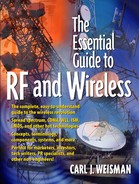Chapter 2. RF Behavior
This chapter describes the behavior of RF energy, whether it is a signal in a circuit or a wave in the air. You are introduced to two fundamental concepts affecting all RF energy: loss and gain. RF energy is constantly changing as it moves around: it gets bigger, it gets smaller, and it gets distorted. Sometimes these changes are intentional and sometimes they are just an unwanted fact of life in the world of RF.
You will learn how the concept of frequency can be expanded to describe a very important parameter of all RF items called bandwidth. The performance of any RF item depends on its bandwidth. Bandwidth can also be used to define an RF application's "boundary." All wireless applications are restricted to their predetermined frequency boundaries. In the United States, these boundaries are determined by the Federal Communications Commission (FCC), which has the authority to not only select the exact frequencies and uses for each bandwidth, but also has the responsibility to enforce their declarations. It ensures that no party transmits an RF signal at an unauthorized power level or frequency, or for an unauthorized use.
In this chapter, the concepts of absorption and reflection are used to describe what happens to RF waves as they encounter solid objects, which they often do when traveling around as waves. Some applications are adversely affected by this behavior, while others depend on it.
Finally, this chapter introduces you to an interesting term called match and its two methods of measurement: VSWR and return loss.
